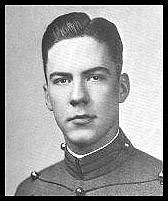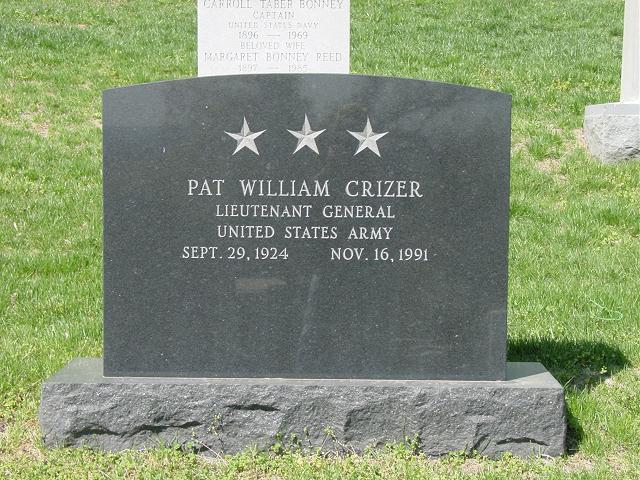Courtesy of his classmates
United States Military Academy Class of 1946
Pat William Crizer No. 15990 Class of 1946
Died 16 November 1991 in Williamsburg, Virginia, aged 67 years.
Interment: Arlington National Cemetery

Cadet life was uneventful for Pat, except for plebe year. One of his roommates, Jim Johnson, recalled: “Plebe year was difficult for Pat . While he avoided the Tactical Department and the area, somehow he became the favorite target of an unrelenting first classman. This extra demand on his time and concentration caused him some worrisome difficulties with plebe math. Nevertheless, he always maintained his sense of humor and composed disposition.” Another roommate, Ray Boyd, recalled: “Pat was always cheerful and cooperative. Pat handled underclassmen in a fair and professional manner, which was an indication of his leadership potential in later troop assignments.” When graduation rolled around, Pat became an Infantry second lieutenant.
Following basic schooling, Pat was assigned to the 21st Infantry, 24th Division in Japan. He returned to the States in 1949 and married Frances Louise Owens in Washington, D.C. on 24 May 1950. Assigned to the 7th Infantry, 3d Division, Pat entered the Korean War in November 1950. For five months, he served as Assistant S-3 and then S-3, 3-7 Infantry. In March of 1951 Pat became Commander, K Company, 3-7 Infantry. He was awarded two Silver Stars for valor in combat. Returning to the States, Pat attended the Advanced Course and was subsequently assigned to the Reserve Officer Training Corps unit at Valley Forge Military Academy. He obtained his MBA from Syracuse and served in the Office of the Army Comptroller in Washington. Selected to attend the Command and General Staff College in 1959, Pat was asked to serve on the faculty.
In 1962 Pat served in Headquarters, European Command, returning to the States in 1964 to attend the Army War College. From there he went to Fort Lewis, Washington to take command of the 38th Infantry, 4th Infantry Division. Pat deployed with the division to Vietnam in September 1966, commanding his battalion in combat until December, when he became the G-2. Pat next commanded 3rd Brigade, 5th Mechanized Division before serving in the Office of the Vice Chief of Staff of the Army. Selected for brigadier general, Pat served as Assistant Division Commander, 2d Infantry Division in Korea. Lieutenant General Jeffrey G. Smith, US Army, Retired, recalled: “My close, personal ties with Pat began 20 years ago when Pat Crier welcomed me as I assumed command of the 2nd Infantry Division. The Army, as a whole, had been shaken severely by the instabilities and turmoil thrust upon it as the Vietnam War wound down. Pat and I shared the job of carrying on. That entailed an emphasis–trite as that might sound to those who did not experience those days or might have forgotten–on the fundamentals of soldiering; training, discipline, and, above all, straight talk and no gimmicks. Pat Crizer was a much-needed, much-appreciated example of perseverance, perception, common sense and moral courage”
From Korea, Pat returned to the Pentagon to serve as Director of Systems, Office of the Assistant Chief of Staff for Force Development and then as Director of Requirements, Office of the Assistant Chief of Staff for Operations. The Crizers returned to Germany when Pat was promoted to major general commanding the 3d Infantry Division. General Frederick J. Kroesen, US Army, Retired, remembered: “As a brand new corps commander, I learned that Pat Crizer was to command the 3d Infantry Division. I was quite satisfied with that assignment, not realizing at the time that it was the beginning of a friendship that would last through the rest of his life. The 3d Division was special for Pat. He nurtured his division, trained it as well, maybe better than any other in the Army at the time, and developed a camaraderie, esprit de corps, and a professional respect between himself and his officers and men.” General George S. Blanchard, US Army, Retired, recalled Pat’s command of the 3d Division: “He was an outstanding division commanding general and I remember one Reforger when, through his division’s brilliance, the ‘enemy’ was completely befuddled and practically collapsed.” A classmate and close friend, Major General, US Army, Retired, Dick Bresnahan, wrote: “Recently I met an officer who had commanded a division with great success in the Middle East War. He had been a major in the 3d Division when Pat commanded it. He said. ‘Much of my success and that of several other officers over there was the result of lessons we learned from General Crizer while serving under him. He knew his business and was a great teacher.’ What else is there to say about such a loyal friend?”
Pat and Fran returned to the States to command the US Army Readiness Region III and to be Deputy CG First US Army, at Fort Meade, Maryland. In 1978 General Blanchard specifically asked Pat to be his Deputy Commander-in-Chief US Army Europe. “He did a great job as deputy commander-in-chief, relieving me of many important tasks and always looking out for the troops. I burdened the deputy commander-in-chief with many command responsibilities. He wasn’t just a deputy.” General Kroesen remembered: “I was more than happy to recommend Pat’s selection, never suspecting that within months I would be reunited with him in that headquarters. I congratulated myself for having had a voice in his appointment, then spent the last two years of his career in a rewarding, mutually beneficial partnership commanding the activities of the vast organization. He continued to be a 3d Division man, jealously insisting that ‘The Dogface Soldier’ was the exclusive property of the Rock of the Marne.”
Pat retired in 1981 as a lieutenant general. He became a consultant to Burdeshaw Associates in Washington, DC. In 1983, Pat and Fran moved to Williamsburg, Virginia, where Pat honed his already good golf game and participated in many community activities. In 1990, Pat learned he had acute leukemia and, though he fought valiantly, he died 16 November 1991. He is survived by his wife Fran; a daughter, Candice; a son, Scott; and four sisters; Wilma, Louise, June and Sue.
It was hard for Pat’s family, friends and classmates to assimilate the fact that this bright shining light in their firmament was no longer shining. He made a deep impression on everyone who ever knew him. This is exemplified by the comments of his friends from Kingsmill on the James, near Williamsburg, Virginia.
Alfred A. Lawton wrote: “Although I only knew Pat for some six years, I consider it a privilege and it certainly was a great pleasure. Pat will be greatly missed; he was a leader wherever he went.”
G. Richard Johnson wrote: “There are many examples of Pat’s involvement in everything that was worthwhile. In the course of his participation, he endeared himself to everyone with his warmth, friendliness and sincerity…. I expect that Heaven will be just a little bit nicer because of Pat’s presence.
James E. Elliot wrote: “Pat was a very humble and gracious person. He did not flaunt his accomplishments and asked that he be judged by his current actions, and he judged others likewise.”
Harry Kane wrote: “I’ll remember Pat for many different reasons. He not only worried about the economic and political challenges that confront our great country but sought to shape response to them. West Point is entitled to be very proud of him; after they made him a good soldier, he became a good father and a good citizen.”
General Kroesen closed his remembrance with: “And now, the world is a lesser place because he is gone. I will miss him.”
General Bruce Palmer, US Army, Retired. Wrote: “Pat Crizer was one of the finest men that I have ever known — truly a straight shooter. There was nothing artificial about him. But, I remember him best as a devoted husband and family man. Pat and Fran and their two children, Scott and Candy, were very close together they shone like bright stars.”
Dick Bresnahan added: “Pat was the highest principled man I’ve ever known. In combat, I can only say I would have wanted him on my flank under the most challenging situations.
Lieutenant General Smith, in his eulogy at Pat’s funeral stated: “In the end, his service and example more than repaid all that West Point and his country gave him. Elan and distinction–and humility– were Pat Crizer hallmarks. As were the spring in his step, the twinkle in his eye and his distinctive bearing. Pat would, I suspect, like best to be remembered as a caring husband and father who was ‘just a dog-faced soldier with a rifle on his soldier’ from the Third Division. There was, however, much more than that.”
The Class of 1946 joins the family and friends of Pat William Crizer in proclaiming to the world; “Well Done, Pat! Be Thou At Peace!”
’46 Memorial Article Project and his wife, Fran
Michael Robert Patterson was born in Arlington and is the son of a former officer of the US Army. So it was no wonder that sooner or later his interests drew him to American history and especially to American military history. Many of his articles can be found on renowned portals like the New York Times, Washingtonpost or Wikipedia.
Reviewed by: Michael Howard

